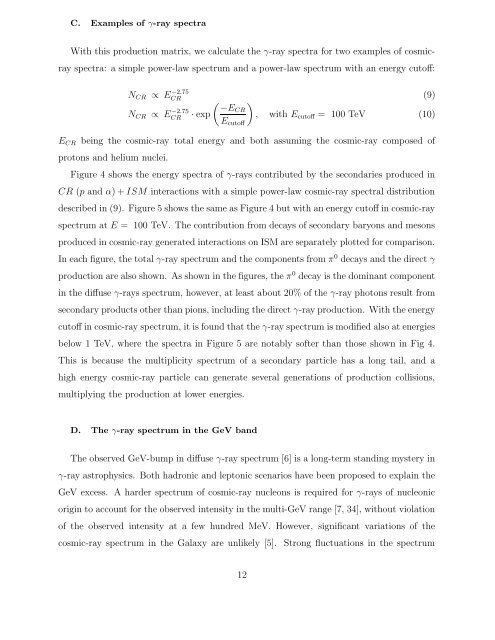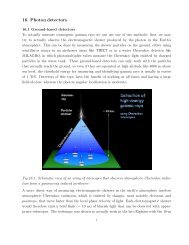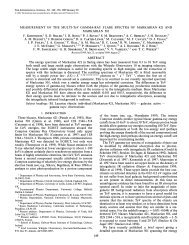Gamma-Rays Produced in Cosmic-Ray Interactions and TeV-band ...
Gamma-Rays Produced in Cosmic-Ray Interactions and TeV-band ...
Gamma-Rays Produced in Cosmic-Ray Interactions and TeV-band ...
Create successful ePaper yourself
Turn your PDF publications into a flip-book with our unique Google optimized e-Paper software.
C. Examples of γ-ray spectra<br />
With this production matrix, we calculate the γ-ray spectra for two examples of cosmicray<br />
spectra: a simple power-law spectrum <strong>and</strong> a power-law spectrum with an energy cutoff:<br />
E CR<br />
N CR ∝ E −2.75<br />
CR<br />
(9)<br />
N CR ∝ E −2.75<br />
CR<br />
( )<br />
· exp<br />
−ECR<br />
, with E cutoff = 100 <strong>TeV</strong> (10)<br />
E cutoff<br />
be<strong>in</strong>g the cosmic-ray total energy <strong>and</strong> both assum<strong>in</strong>g the cosmic-ray composed of<br />
protons <strong>and</strong> helium nuclei.<br />
Figure 4 shows the energy spectra of γ-rays contributed by the secondaries produced <strong>in</strong><br />
CR (p <strong>and</strong> α) + ISM <strong>in</strong>teractions with a simple power-law cosmic-ray spectral distribution<br />
described <strong>in</strong> (9). Figure 5 shows the same as Figure 4 but with an energy cutoff <strong>in</strong> cosmic-ray<br />
spectrum at E = 100 <strong>TeV</strong>. The contribution from decays of secondary baryons <strong>and</strong> mesons<br />
produced <strong>in</strong> cosmic-ray generated <strong>in</strong>teractions on ISM are separately plotted for comparison.<br />
In each figure, the total γ-ray spectrum <strong>and</strong> the components from π 0 decays <strong>and</strong> the direct γ<br />
production are also shown. As shown <strong>in</strong> the figures, the π 0 decay is the dom<strong>in</strong>ant component<br />
<strong>in</strong> the diffuse γ-rays spectrum, however, at least about 20% of the γ-ray photons result from<br />
secondary products other than pions, <strong>in</strong>clud<strong>in</strong>g the direct γ-ray production. With the energy<br />
cutoff <strong>in</strong> cosmic-ray spectrum, it is found that the γ-ray spectrum is modified also at energies<br />
below 1 <strong>TeV</strong>, where the spectra <strong>in</strong> Figure 5 are notably softer than those shown <strong>in</strong> Fig 4.<br />
This is because the multiplicity spectrum of a secondary particle has a long tail, <strong>and</strong> a<br />
high energy cosmic-ray particle can generate several generations of production collisions,<br />
multiply<strong>in</strong>g the production at lower energies.<br />
D. The γ-ray spectrum <strong>in</strong> the GeV b<strong>and</strong><br />
The observed GeV-bump <strong>in</strong> diffuse γ-ray spectrum [6] is a long-term st<strong>and</strong><strong>in</strong>g mystery <strong>in</strong><br />
γ-ray astrophysics. Both hadronic <strong>and</strong> leptonic scenarios have been proposed to expla<strong>in</strong> the<br />
GeV excess. A harder spectrum of cosmic-ray nucleons is required for γ-rays of nucleonic<br />
orig<strong>in</strong> to account for the observed <strong>in</strong>tensity <strong>in</strong> the multi-GeV range [7, 34], without violation<br />
of the observed <strong>in</strong>tensity at a few hundred MeV. However, significant variations of the<br />
cosmic-ray spectrum <strong>in</strong> the Galaxy are unlikely [5]. Strong fluctuations <strong>in</strong> the spectrum<br />
12







